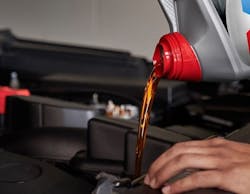As vehicles become more complex, engine oils will continue to follow suit, according to officials from Valvoline and Shell Lubricants.
“Engines are being asked to run hotter and incorporate newer technologies in order to (achieve) better efficiency and increase power,” says Sean Nguyen, Pennzoil scientist and automotive lubricant specialist, Shell Lubricants. “And engine manufacturers have shifted to a more fuel economy-based approach.”
This has forced oil manufacturers to “make thinner-weight oils to meet these modern requirements. These oils still need to protect engine parts,” while delivering other benefits, including extreme temperature performance.
“We used to see that 10w30 and 5w20 were the most common” viscosity grades, says Mike Warholic, senior technology manager, Valvoline. “And now we see 0w20 and 5w20 being more common.”
Motor oil technology has improved in other areas. “The first is base oil quality,” says Nguyen. “Quality has improved dramatically due to improvements in the refining process and the way synthetic oils are made.
“We know that synthetic oil goes through chemically engineered processes and the molecules in these oils are what we would describe as (having) more uniform properties, with fewer impurities.”
Additives in oils also have improved significantly, he explains. “Top-tier oil manufacturers and suppliers have turned to better ingredients. And these ingredients are not just for one characteristic in the formulation. They have synergistic, dual-purpose properties.”
Inventory challenges
More than 80% of respondents to MTD’s latest Tire Dealer Automotive Service Survey offer oil changes at their locations at an average of 205 jobs per month.
There will be plenty of oil change work for dealers in the years ahead, even as the North American vehicle population continues to electrify, according to Warholic.
“In the aftermarket arena, shops are still seeing old vehicles. The key is having the right inventory mix to cover those older vehicles, but also to cover new vehicles. It can be a bit of a struggle.”
Original equipment vehicle manufacturers (OEMs) also can specify certain engine oils for different cars, SUVs, CUVs and light trucks, he says. “It gets complicated quickly.”
Geography also can play a role, adds Warholic. Tire dealers in rural areas “might see more trucks and larger SUVs. In the city, they may see smaller vehicles. If you’re in a warmer region, you may not need (to stock) oil that has the same low-temperature properties” required in northern climates.
“You have to know your customers and you have to know what they’re driving in order to have the right oil on hand at the right time.”
The right interval
Oil change intervals have lengthened. But that doesn’t mean vehicle owners should press their luck. Dealers should encourage customers to follow auto manufacturer-dictated oil change intervals.
“A lot of people think motor oil manufacturers control intervals,” says Nguyen. “It’s the manufacturer of the engine that controls the intervals. They know the nuances of what their engines can do.”
“Oils have gotten a lot better, which allows them to go longer — but not forever,” says Warholic. “There are components in oil that break down no matter what. Every oil has a finite life. Three thousand miles is the low end now. Typically, 5,000 miles is the (new) minimum.
“We always say, ‘Follow OEM guidelines, whether it’s a fixed number in a manual or (a vehicle’s) on-board computer, which will tell you, ‘Hey, change the oil now.’
“The OEMs do a lot of testing to make sure you have the right oil in your engine and that they’re prescribing the right intervals to make sure the engine is protected. OEMs are very sensitive to that.”
About the Author
Mike Manges
Editor
Mike Manges is Modern Tire Dealer’s editor. A 28-year tire industry veteran, he is a three-time International Automotive Media Association Award winner, holds a Gold Award from the Association of Automotive Publication Editors and was named a finalist for the prestigious Jesse H. Neal Award, the Pulitzer Prize of business-to-business media, in 2024. He also was named Endeavor Business Media's Editor of the Year in 2024. Mike has traveled the world in pursuit of stories that will help independent tire dealers move their businesses forward. Before rejoining MTD in 2019, he held corporate communications positions at two Fortune 500 companies and served as MTD’s senior editor from 2000 to 2010.

